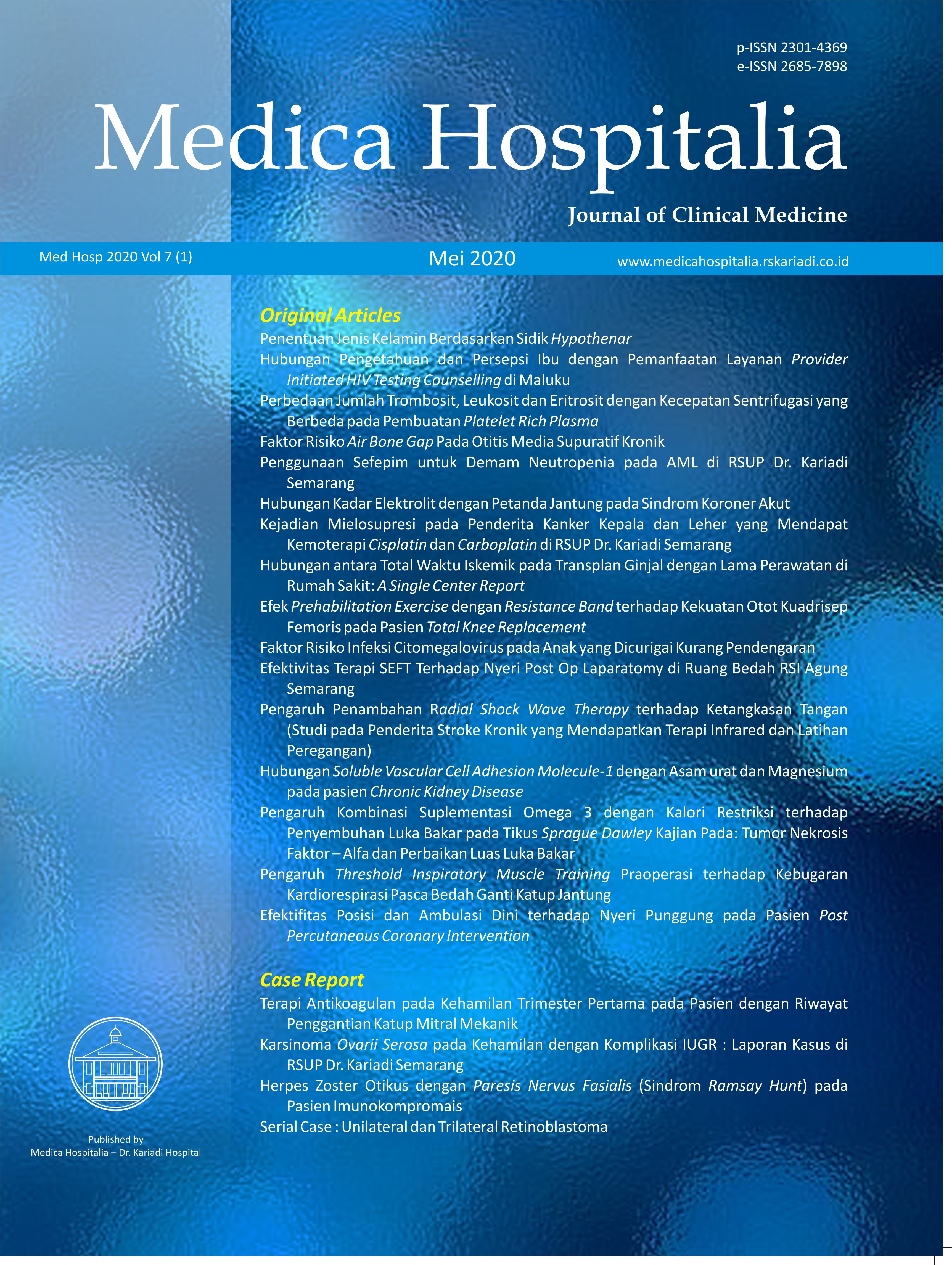Perbedaan Jumlah Trombosit, Leukosit Dan Eritrosit Dengan Kecepatan Sentrifugasi Yang Berbeda Pada Pembuatan Platelet Rich Plasma
DOI:
https://doi.org/10.36408/mhjcm.v7i1.421Keywords:
PRP, trombosit, leukosit, eritositAbstract
Latar belakang : Platelet Rich Plasma (PRP) adalah plasma dalam jumlah sedikit dengan jumlah trombosit banyak, didapatkan melalui sentrifugasi. Trombosit dalam PRP penting untuk penyembuhan luka dan memperbaiki jaringan rusak. Kecepatan sentrifugasi berperan penting dalam memisahkan sel darah merah dengan plasma dan menghasilkan platelet konsentrat. Penelitian ini bertujuan untuk mengetahui perbedaan jumlah trombosit, leukosit dan eritrosit dengan kecepatan sentrifugasi yang berbeda pada pembuatan platelet rich plasma.
Metode: Penelitian belah lintang pada orang sehat di laboratorium RSUP Dr. Kariadi Semarang bulan Juli 2018. Darah vena ditampung dalam tabung sitras dan Ethylenediaminetetraacetic acid (EDTA). Darah EDTA untuk pemeriksaan hematologi rutin dengan hematology analyzer, hasil normal dilanjutkan pembuatan PRP dari darah sitras 3,2 % dengan dua metode sentrifugasi, dengan kecepatan 100xg-400x selama 10 menit (metode PRP1) dan kecepatan 540xg-2270xg selama 10 menit (metode PRP2). Kedua produk PRP dilakukan pemeriksaan jumlah trombosit, leukosit dan eritrosit. Data dianalisis dengan uji Kruskall Wallis dan Mann Whitney, signifikan bila p< 0.05.
Hasil : Sampel terdiri dari 35 orang responden. Terdapat perbedaan bermakna jumlah trombosit, leukosit dan eritrosit pada pembuatan PRP-1 dan PRP-2 (p<0.001)
Simpulan : Terdapat perbedaan jumlah trombosit, leukosit dan eritrosit pada kecepatan sentrifugasi yang berbeda. Kecepatan sentrifugasi pada metode pembuatan PRP disarankan dalam pembuatan PRP.
Kata kunci : PRP, trombosit, leukosit, eritrosit
Background : Platelet Rich Plasma (PRP) consisting of small amounts plasma with many platelet, which was obtained by centrifugation process. The platelet in PRP are essential for wound healing and repair of damaged tissue. The centrifugation velocity plays an important role in separating red blood cells by plasma and producing concentrated-platelets. This study aims to determine differences the number of platelets, leukocytes and erythrocytes with different centrifugation rates on platelet rich plasma production.
Methods: This cross sectional study was conducted on 35 healthy people in the laboratory of Kariadi Hospital Semarang in July 2018. The blood vein were collected in Citrate 3.2 % and Ethylenediaminetetraacetic acid (EDTA) tubes. Sample EDTA for complete blood counts, if the results were normal then continued with PRP preparation in 2 different methods centrifugation (PRP 1 at 100xg-400xg for 10 minutes and PRP 2 at 540xg-2270 xg for 10 minutes). Both of the PRP products were calculated the amounts of platelet, leukocytes, and erythrocytes. The data were analyzed by Kruskall Wallis and Mann Whitney, p < 0.05 was considered as significant.
Results : There was a significant difference between PRP-1 and PRP-2 method in platelet counts, leukocytes count and erythrocytes count (p<0.001).
Conclusion : There was differences in platelet count, leukocytes count and erythrocytes count with different centrifugation rate. Centrigugation rate on PRP-1 method is recommended in the production of PRP.
Keyword
PRP, platelets, leukocytes, erythrocytes
Downloads
References
2. Lee JW, Kwon OH, Kim TK, Cho YK, Choi KY, Chung HY, et al. Platelet-Rich Plasma: Quantitative Assessment of Growth Factor Levels and Comparative Analysis of Activated and Inactivated Groups. Arch Plast Surg. 2013;40:530-5.
3. Khalafi RS, Bradford DW, Wilson MG. Topical application of autologous blood product during surgical closure, folowing a coronary artery bypass graft. Eur J Cardiothorac Surg. 2008;34:360-4.
4. Budiyanto A. Penggunaan PRP di bidang dermatologi. Bagian/SMF Ilmu kesehatan Kulit dan kelamin. FK UGM/RSUP Dr. Sardjito Yogyakarta. Available from : http://andinanendra.wordpress.com/2011/prp-for-skin-rejuvent
5. Perez AGM, Lana JFSD, Rodrigues AA, Luzo ACM, Belangero WD, Santana MHA. Relevant aspects of centrifugation step in the preparation of platelet rich plasma. Hindawi. ISRN Hematology. 2014.
6. Kamruzzaman BM, Hasan A , Dhingra N. Standard Operating Procedures for blood tranfusion, Directorate general of health services (BANBCT), Mokhali Technical Assistance by WHO and Supported by The OPEC Fondation for International Development, 2013. Available from www.who.int/bloodsafety /tranfusion_service/sop-bts_bangladesh
7. Plao L, Park H, Jo CH. Theoritical prediction and validation of cell recovery rates in preparing platelet rich plasma through a centrifugation. PLOS ONE. 2017;12(11): 1-25.
8. Kaushansky K, Lichtman MA, Kipps TJ, Prchal JT, Levi MM. Williams Hematology eight edition, 2010.
9. Bausset O, Giraudo L, Veran J, Magalon J, Coudreuse JM, Magalon G, et al. Formulation and storage of platelet rich plasma homemade product. BioResearch Open Access, Mary Ann Liebert, Inc. 2012;1(3):115-23.
10. Nugraha HK, Muljanti M, Hernaningsih Y, Nugraha J. Platelet rich plasma protocols : A Preliminary Study. Indonesia journal of tropical and infectious disease. 2012;3(2):104-7
11. Raturi M, Shastry S, Raj P. Cumulative quality asessment for whole Blood-derived platelets : a complience review. Global Journal of Transfusion Medicine. 2017;2:38-43.
12. Satyam A. Preparation and quality control of autologous platelets for
therapeutic applications. Clinical Association Departement of Tranfusion
Medicine. BLK Super Speciality Hospital, NewDelhi. 2015. Available from :https://www.researchgate.net
Additional Files
Published
How to Cite
Issue
Section
Citation Check
License
Copyright (c) 2020 Medica Hospitalia : Journal of Clinical Medicine

This work is licensed under a Creative Commons Attribution-ShareAlike 4.0 International License.
Copyrights Notice
Copyrights:
Researchers publishing manuscrips at Medica Hospitalis: Journal of Clinical Medicine agree with regulations as follow:
Copyrights of each article belong to researchers, and it is likewise the patent rights
Researchers admit that Medica Hospitalia: Journal of Clinical Medicine has the right of first publication
Researchers may submit manuscripts separately, manage non exclusive distribution of published manuscripts into other versions (such as: being sent to researchers’ institutional repository, publication in the books, etc), admitting that manuscripts have been firstly published at Medica Hospitalia: Journal of Clinical Medicine
License:
Medica Hospitalia: Journal of Clinical Medicine is disseminated based on provisions of Creative Common Attribution-Share Alike 4.0 Internasional It allows individuals to duplicate and disseminate manuscripts in any formats, to alter, compose and make derivatives of manuscripts for any purpose. You are not allowed to use manuscripts for commercial purposes. You should properly acknowledge, reference links, and state that alterations have been made. You can do so in proper ways, but it does not hint that the licensors support you or your usage.

























